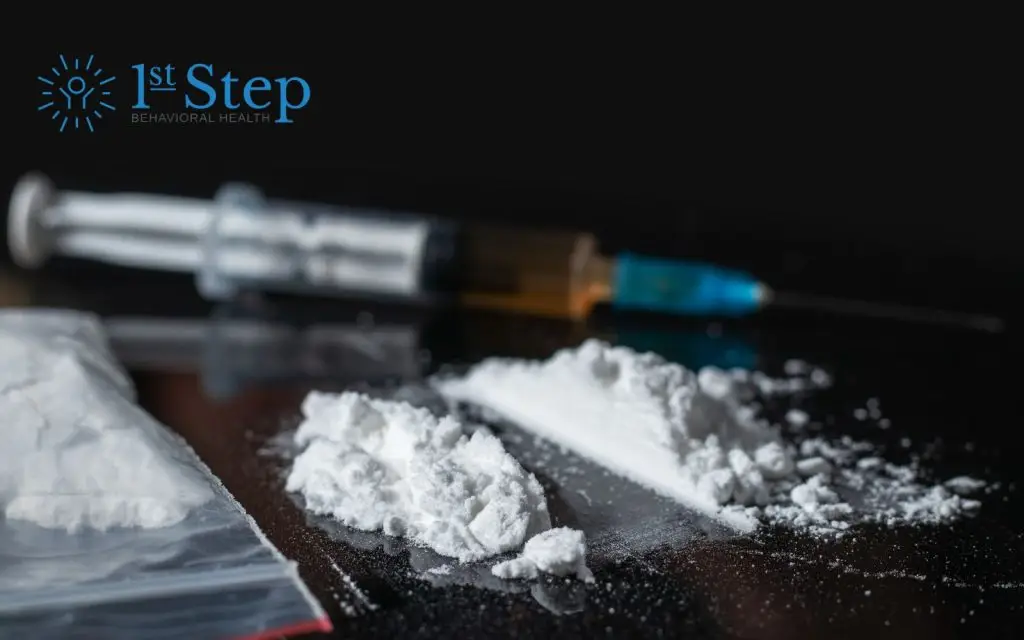Mixing heroin, a central nervous system (CNS) depressant, with cocaine, a CNS stimulant, is often referred to as a speedball. Speedballing, the act of taking a speedball, is extremely dangerous, potentially leading to overdose and a range of long-term side effects.
In this article, you will learn:
- What is a speedball
- What drugs are in a speedball
- The side effects
- Long-term risks
If you or a loved one is struggling with substance abuse, please reach out to our team at First Step Behavioral Health to explore your treatment options.
What is Speedballing?
The term ‘speedballing’ refers to getting high by using a central nervous system (CNS) depressant, usually an opioid, in combination with a stimulant. Similarly, a speedball refers to a mixture or cocktail of mood-and-mind-altering drugs.
A classic speedball is an injection that contains heroin and cocaine, however, today a speedball may contain any number of drug mixtures, including:
- Cocaine and heroin
- Cocaine and fentanyl
- Meth and heroin
- Meth and fentanyl
- Prescription stimulants (such as Adderall or Desoxyn) and prescription opioids (i.e. oxycodone or morphine)
Drug users may take speedballs to amplify the effects of both drugs while also minimizing the negative side effects of them. For example, opioids can make people drowsy, so in theory, taking a stimulant while using opioids will reduce the sedating effects, allowing people to continue feeling the euphoria while staying awake.[1] On the other hand, stimulants like cocaine and meth can cause anxiety and agitation.[2] Opioids have a relaxing effect, so they can reduce some of the unwanted effects of stimulants.
While minimizing the unwanted side effects may sound like a positive thing, the opposite effects of stimulants and depressants create a “push-pull” reaction in the body, placing a substantial strain on many vital organs, including the heart, liver, and kidneys.
Mixing drugs is incredibly dangerous and comes with an enhanced risk of adverse side effects including overdose and death.
Side Effects of Taking a Speedball
Opioids work by binding to opioid receptors in the brain and other parts of the body, suppressing pain and inducing feelings of euphoria and relaxation. This can lead to respiratory depression and a decrease in heart rate.[1]
On the other hand, stimulants like cocaine or amphetamines increase heart rate, blood pressure, and alertness by affecting neurotransmitters like dopamine and norepinephrine. People who take stimulants may be more talkative, attentive, and energetic.[2]
Mixing stimulants and opioids can amplify the side effects. Common effects of mixing heroin and cocaine are:[3]
- Euphoria
- Drowsiness
- Paranoia
- Stupor
- Confusion
- Incoherence
- Blurry vision
- Uncontrollable movements
- Mental impairment
The Dangers of Speedballing
Since opioids can mask some of the stimulant effects of cocaine and vice versa, it can become difficult to tell when you’ve taken too much. This results in an increased risk of adverse side effects, such as depression, paranoia, racing heartbeat, cognitive impairment, and manic episodes. It also increases the risk of a drug overdose.
Potentially life-threatening risks of speedballing include:
- Heart attack
- Stroke
- Aneurysm
- Respiratory failure
- Respiratory depression
Respiratory depression and failure is of particular concern when it comes to mixing cocaine and heroin. Cocaine is a short-acting drug, and the effects of it wear off faster than the effects of heroin. When the effects of cocaine wear off, the sedating effects of heroin begin affecting the body in full force, potentially leading to an overdose.
Long-Term Risks
While overdose is the primary immediate threat associated with speedballing, it is also linked to a number of long-term health risks.
- Physical dependence
- Addiction
- Abscesses or cellulitis from injecting
- Contracting HIV or other bloodborne illnesses from needle sharing
- Cognitive impairment
- Kidney failure
- Liver failure
- Heart muscle inflammation
- Vascular inflammation
- Seizures
- Stroke
- Malnourishment
- Aortic ruptures
- Heart attack
Overdose Risk
The risk of overdose with speedball drugs has never been higher than it is today. This is primarily due to fentanyl, a powerful opioid that is 50 times stronger than heroin and 100 times stronger than morphine. A tiny, granule-sized amount can be lethal in people who don’t have a tolerance for opioids.
Fentanyl is often found in heroin, cocaine, meth, and counterfeit prescription pills. Tasteless, colorless, and odorless, it is impossible to detect unless you test for it, and it can cause a life-threatening overdose in a matter of seconds.
A report published by the Centers for Disease Control and Prevention (CDC) found that from 2011-2021, the rate of drug overdose deaths involving both cocaine and opioids increased more quickly than the rate of overdose deaths involving cocaine without opioids. Overdose deaths involving cocaine and opioids were 7.4 times higher in 2021 than it was in 2011.[4] In 2022, overdose deaths involving synthetic opioids (primarily fentanyl) reached a new high of 73,838.[5]
Get Addiction Help Today
If you or a loved one are struggling with heroin or cocaine addiction, please don’t hesitate to reach out for help. At First Step Behavioral Health, we are a licensed dual-diagnosis long-term addiction treatment facility that is accredited by the Joint Commission. We focus on the physiological rebalancing of the individual through medical, physical, emotional, mental, and spiritual care.
To learn more about our addiction treatment and mental health programs or to get started with a confidential, risk-free assessment, please contact us today.
References:
- Johns Hopkins Medicine: Opioids
- Drug Enforcement Administration (DEA): Stimulants
- Science Direct: The Synergistic Effects of Combining Cocaine and Heroin (“Speedball”) Using a Progressive-Ratio Schedule of Drug Reinforcement
- Centers for Disease Control and Prevention (CDC): Co-involvement of Opioids in Drug Overdose Deaths Involving Cocaine and Psychostimulants, 2011–2021
- National Institute on Drug Abuse (NIDA): Drug Overdose Death Rates
Jump to a Section
Call (855) 425-4846
